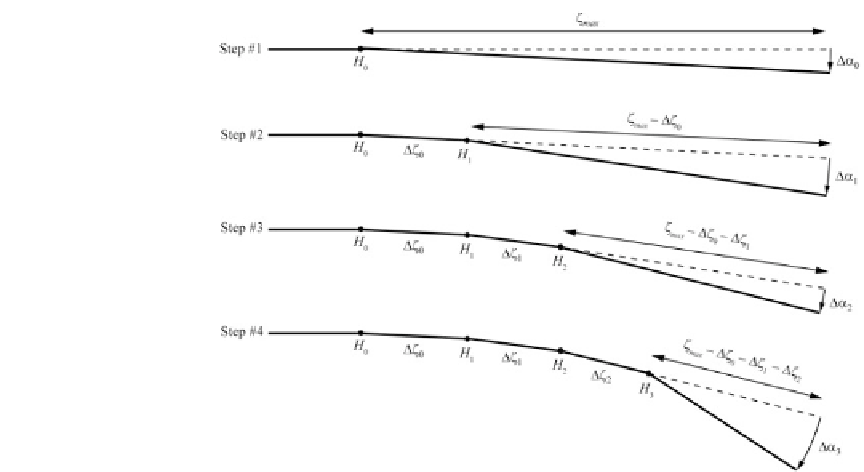Geology Reference
In-Depth Information
Fig. 11.8
Conceptual
method of construction of
down-dip slab geometries.
At step #1, a line having
length —
max
is rotated by
angle '
0
about a hinge
H
0
at depth zero. Then, at
the next step, a line
segment having length
—
max
—
0
is rotated by
angle '
1
about
H
1
.At
step #
n
, a line segment
having length
n
X
1
—
max
—
k
is rotated
k
D
0
by an angle '
n
"
1
¡
2
1=2
Z
x
intermediate depths (300-400 km), where values
close to Frank's equilibrium condition are often
reached.
Expression (
11.29
) can be used to plot the
theoretical lateral strain rate as a function of the
slab dip. Such curves are more readily compa-
rable with the observed data along vertical cross
sections. Figure
11.10
illustrates the dependence
of the lateral strain rate from the dip angle for sev-
eral trench curvatures. We note that the range of
angles for which lateral shortening is predicted is
reduced when the radius of curvature decreases.
These results imply that bending of slabs is al-
ways accompanied by lateral deformation that
superimposes on downdip strain. In particular,
slabs are always in a state of lateral shortening at
shallow depths, and they eventually go in a state
of lateral extension at intermediate depth, espe-
cially when the radius of curvature ¡ is small and
the dip angle ' is large. Therefore, we expect that
subducting lithospheres like that which is sinking
beneath the Mariana Trench (¡
D
738 km) in the
western Pacific, or that which is subducting be-
neath the South Sandwich Trench (¡
D
346 km)
in the South Atlantic, are subject to large lateral
extension at intermediate depths. Schettino and
Tassi (
2012
) showed that this is exactly what
is observed on the basis of the Wadati-Benioff
seismicity.
sin '
x
0
1
R
2
P
©.x/
D
v
0
R
cos '
x
0
d'
x
0
D
v
"
.1
cos '.x//
1
1
R
2
1=2
1
¡
2
R
sin '.x/
1
(11.29)
Expression (
11.29
) is particularly interesting,
because it shows that the solution (
11.27
) is valid
also when the slab dip changes with depth. In
general, the lateral strain rate
P
© at some depth
z
,oroffset
x
, will depend only from the slab
dip ' at the same depth (or at the corresponding
horizontal offset). Plots of the lateral strain as a
function of the bending angle, ', are illustrated
in Fig.
11.9
for different horizontal offsets
x
from
the hinge line. These curves have been traced in
the simple case of a constant bending angle ('(
x
)
D
const
) through (
11.26
). They show that a small
component of compressional strain at shallow
depths is always present during the bending of a
lithospheric slab. However, the typical geometry
of many Wadati-Benioff zones presents a dip
angle increasing progressively from the bulge to




